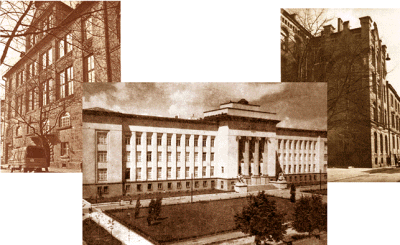History of the Library
The Main Library of the AGH University of Science and Technology is the largest technical library in Kraków and one of the biggest in Poland. Its history is connected with Polish history and the stages of the development of the University itself. On 20th October 1919 Marshal Józef Piłsudski, the leader of the country, presided over the grand inauguration of the University of Mining. First, the Faculty of Mining was established. After the first two years of its operation (1921), another faculty was created: the Faculty of Metallurgy. By 1939, about 800 engineers of mining and metallurgy had graduated from the University.
The Library came into being in the academic year of 1921 and 1922 and it was set up by the Senate Library Comission. At the beginning it was located in the building at 18 Loretańska Street and then it was moved to 7 Smoleńsk Street. In 1929 library collection was transferred to a newly erected building at 30 Mickiewicz Avenue.

Buildings in which the collection was held
The collection was build up thanks to gifts from private donors, mainly AGH professors and Polish and foreign institutions, including Maria Skłodowska-Curie, who, acting in the Intellectual Co-operation Committee for the League of Nations, organised an exchange of French journals in return for the scientific publications of the University staff. Thus, the collection was enriched with the journal Revue de Metallurgie, to which the Library has been subscribing till today.
In 1938, the Library contained over 17,000 volumes, including 5,000 volumes of journals.
During World War II, the books were deposited in the Jagiellonian Library. In spite of the prohibition imposed by the German authorities who ruled occupied Poland, the books were secretly lent to the University students and employees, as the University did not suspend its activity. The professors delivered secret lectures and, as a result, 278 examinations were taken, 16 dissertations were written and 1 doctoral thesis was completed (it was, however, defended only after the end of the war).
After the war, the Library collection was returned to the main building of the University that had been restored after the war damage (following the war turmoil, the number of books was reduced by about 25%).
In 1949, the University change its name to the University of Mining and Metallurgy. During the same year, Władysław Piasecki became the manager (and then the director) of the Library. He held his post until 1972. Thanks to his efforts, a new, separate building was erected and it was formally opened on May 3rd, 1966. In 1987, the building was named after Władysław Piasecki.
After the Library was moved to its new location, it began to develop dynamically. As new courses were introduced at the University, the number of books in the collection and the subject areas they dealt with, increased too.
The 1990s were connected with the development of computerisation. Computers were employed in almost all of the Library’s tasks, ranging from acquisitions to cataloguing, OPAC, circulation and the organisation of access to global electronic resources.
In years 1996-1999 a renovation inside the Library was conducted to extend the area of reading rooms. The functional layout of the basic Library units was changed. In 2010 the renovation of the front elevation of the Library building began, and a decision to build a 7 meter-wide extention to the building from the north side, and to carry out a major renovation was taken. The Library resumed full range functioning in February 2014, and in March that year an official opening of the building took place.
After the expansion the Library area amounts to 6100 m2. Essential changes in user services and the organization of access to collections were introduced. Lending rooms for students and for employees, functioning separately before, were combined into one unit. A number of facilities for disabled users were provided. The changes bore fruit: the Library was distinguished by the City Council in a competition "Cracow without barriers' in the category "public buildings".
An Opes Stacks Zone, offering about 60,000 textbooks, and self-borrowing devices, was created. The Jurnals Reading Room and the General Reading Room were merged into one duplex Main Reading Room (97 sits including 4 sits for individual study). Separately functioning reading rooms: a cartographic one and the standards and patents reading room were merged into one Standards, Patents, and Cartographic Collection Reading Room (42 sits). A Patent Information Centre, and a Standards Information Point are functioning within the Special Collections Department. The Self-Study Reading Room was enlarged, and it also plays the role of a conference room with its own audio-visual system.
In 2013 a conceptual work on the project " AGH University Repository" began. In 2015 library employees started entering theses from individual faculties to the Repository. Within this project another subproject "AGH University history" is conducted. It includes biographies of people connected with the AGH University and its history together with the lists of references on them.
The librarians at the Main Library are involved in many local (mainly within the Kraków Library Group) and Polish undertakings (inter alia those initiated by the Executive Board of the Conference of University Libraries Directors). Additionally, they participate in the creation of the National Union Catalogue NUKAT and, further, they develop standards for the operation of scientific libraries in Poland and, finally, they are also involved in activities connected with the digitalisation of the collection.
One of the most important activities on the Main Library is the registration of the AGH university staff scientific output. A Bibliography of AGH University employees, which had been published in print for many years, has been available online since 2001.
Apart from the Main Library, there are also 28 libraries of University units.

The Main Library building